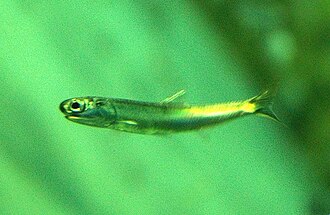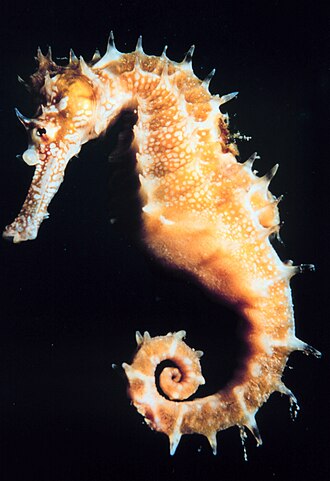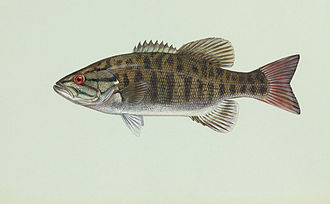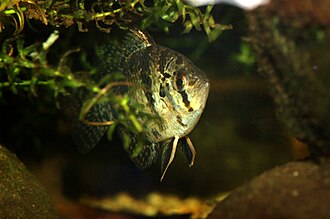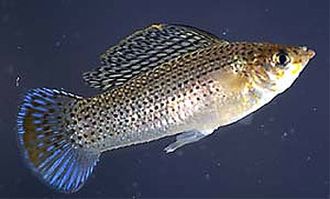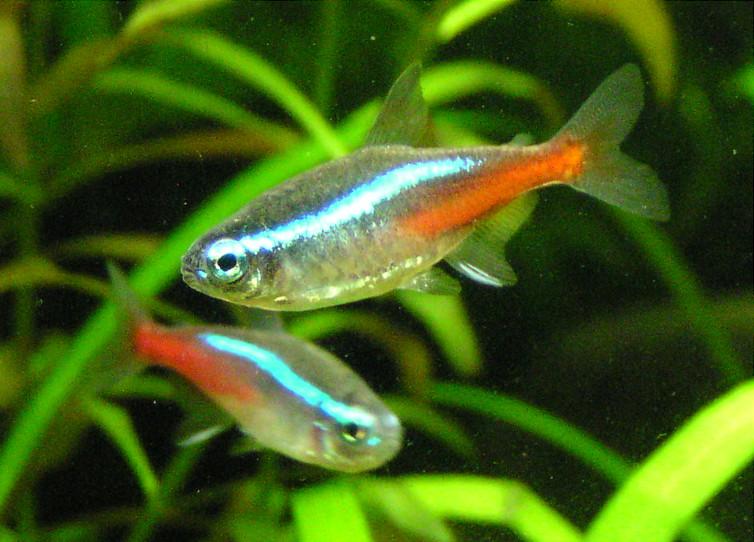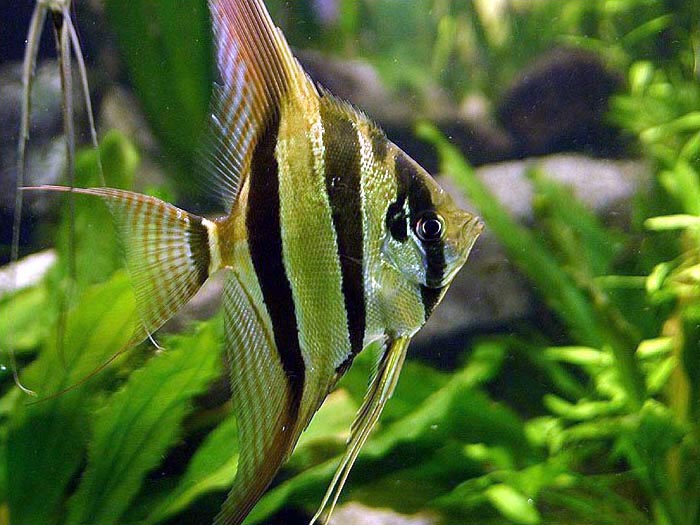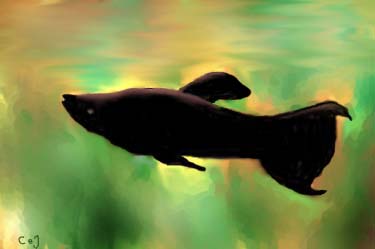AY Honors/Fishes/Answer Key
Template:Honor header Template:AY Master
1. Name ten families of fishes.
2. Identify from pictures or personal observation ten tropical fishes.
a. Explain their breeding habits.
b. Give the habitat or country in which they are found.
Neon Tetra
Neon Tetra (Paracheirodon innesi)
Where found: The Neon Tetra is native to blackwater or clearwater streams in southeastern Colombia, eastern Peru, and western Brazil, including the tributaries of the Solimões. Fish are collected in warm-flowing (21–29°C) clear and blackwater streams, but never in whitewater rivers of Andean origin.
Description: The Neon Tetra has a dark olive-green back over a silver-white abdomen. The fish is characterized by an iridescent blue horizontal stripe along each side of the fish from its nose to the base of the adipose fin, and an iridescent red stripe that begins at the middle of the body and extends posteriorly to the base of the caudal fin. During the night, the color disappears as the fish rests—it reactivates once it becomes active in the morning. It grows to approximately 3 cm (1.25 in) in overall length. Sexual dimorphism is slight, the female having a slightly larger belly.
Reproduction: To breed Neon Tetras, place a pair of the species in a breeding tank without any light, and gradually increase the lighting until spawning occurs. Other inducers include mosquito larvae and a hardness of less than 4 degrees. Some also recommend letting the level of nitrates rise, then do at least 50% water change to simulate the fresh rain the tetras get in their natural habitat, the Amazon. It is recommended that everything you place in the aquarium be sterilized, as well as the aquarium top. Because the adults will often eat newly-hatched fry, it is best to remove them as soon as the eggs have been laid. The eggs are especially sensitive to light. Eggs will hatch within 24 hours of the laying. Fry can be fed rotifers, especially infusoria and egg yolk for 1 to 4 weeks, followed by nauplii of brine shrimp, shaved cattle liver, and formulated diets. Fry will achieve their adult coloration at approximately one month of age. Adults can spawn every two weeks.
Afra Cichlid
Afra Cichlid (Cynotilapia afra)
Where found: This fish is endemic to the central and northern parts of Lake Malawi and is found in rocky habitats.
Description: The afra cichlid has an elongate body typically with vertical blue and black bars. However, there are many different colorations depending on the region the fish is from, for example, the male fish from Kobwe have greenish stripes on blue-black body. They can grow up to 10 cm. Like many other cichlid from Lake Malawi, afra cichlids are mouthbrooders. Males defend boulders as their territories and feed from algae on those boulders. Females congregate in mid-water and feed from plankton.
Reproduction: Like many mbuna cichlids, this is a notoriously aggressive fish that should be kept in a species or mbuna tank. The best practice is to keep one male with several females. They should be provided with large spaces with plenty of hiding shelters.
Angel Fish
Angel Fish (Pterophyllum spp.)
Where found: All Pterophyllum species originate from the Amazon River basin in tropical South America.
Description: The three species of Pterophyllum are unusually shaped for cichlids being greatly laterally compressed, with round bodies and elongated triangular-shaped dorsal and anal fins. This body shape allows them to hide among roots and plants, often on a vertical surface. Naturally occurring angelfish are frequently striped longitudinally, colouration which provides additional camouflage. Angelfish are ambush predators and prey on small fish and macroinvertebrates. All Pterophyllum species form monogamous pairs. Eggs are generally laid on a submerged log or a flattened leaf. As is the case for other cichlids, brood care is highly developed.
Reproduction: P. scalare is relatively easy to breed in the aquarium, although one of the results of generations of inbreeding is that many breeds have almost completely lost their rearing instincts resulting in the tendency of the parents to eat their young. In addition, it is very difficult to accurately identify the gender of any individual until they are nearly ready to breed. Angelfish pairs form long-term relationships where each individual will protect the other from threats and potential suitors. Upon the death or removal of one of the mated pair, some breeders have experienced a total refusal of the other mate to pair up with any other angelfish; others have had more success with subsequent mates. Both parents care for the young. Depending upon aquarium conditions, P. scalare reaches sexual maturity at the age of six to twelve months or more. In situations where the eggs are removed from the aquarium immediately after spawning, the pair is capable of spawning every seven to ten days. Around the age of approximately three years, spawning frequency will decrease and eventually cease. When the pair is ready to spawn, they will choose an appropriate medium upon which to lay the eggs and spend one to two days picking off detritus and algae from the surface. This medium may be a broad-leaf plant in the aquarium, a flat surface such as a piece of slate placed vertically in the aquarium, a length of pipe, or even the glass sides of the aquarium. The female will deposit a line of eggs on the spawning substrate, followed by the male who will fertilize the eggs. This process will repeat itself until there are a total of 100 to up to 1200+ eggs, depending on the size and health of the female fish. The pair will take turns maintaining a high rate of water circulation around the eggs by swimming very close to the eggs and fanning the eggs with their pectoral fins. In a few days, the eggs hatch and the fry remain attached to the spawning substrate. During this period, the fry will not eat and will survive by consuming the remains of their yolk sacs. At one week, the fry will detach and become free-swimming. Successful parents will keep close watch on the eggs until they become free-swimming. At the free-swimming stage, the fry can be fed newly-hatched frozen och fresh (i.e. alive) brine shrimp (Artemia spp.).
Discus
Discus (Symphysodon spp.)
Where found: Discus (Symphysodon spp.) are a genus of three species of freshwater cichlid fishes native to the Amazon River basin
Description: Like cichlids from the genus Pterophyllum, all Symphysodon species have a laterally compressed body shape. In contrast to Pterophyllum, however, extended finnage is absent giving Symphysodon a more rounded shape. It is this body shape from which their common name, “discus”, is derived. The sides of the fish are frequently patterned in shades of green, red, brown, and blue. The height and length of the grown fish are both about 20–25 cm![]() .
.
Reproduction: Another characteristic of Symphysodon species are their care for the larvae. As for most cichlids, brood care is highly developed with both the parents caring for the young. Additionally, adult discus produce a secretion through their skin, off which the larvae live during their first few days. This behaviour has also been observed for Uaru species.
Gold Barb
Gold Barb (Puntius semifasciolatus)
Where found: Its native habitat is the Red River basin in southeast China.
Description: The gold barb is a medium-long barb. Adults have highly arched backs and a short pair of barbels on the upper jaw at the corners of the mouth. The back is light to reddish brown, the sides are metallic green or yellow-green, with a brassy or golden sheen below. The belly is whitish, turning orange-red in males at mating time. Females can be distinguished by their dull colors and their overall bulk. The average size of adults is 7 - 8 cm![]() .
.
Reproduction: An egg-scatterer, adult barbs will spawn around a hundred eggs. This breeding occurs at the first light in the early morning.
Guppy
Guppy (Poecilia reticulata)
Where found: Guppies are native to Trinidad and parts of South America, specifically Antigua and Barbuda, Barbados, Brazil, Guyana, Netherlands Antilles, Trinidad and Tobago, the US Virgin Islands, and Venezuela.
Description: The guppy (Poecilia reticulata) is one of the most popular freshwater aquarium fish species in the world. It is a small member of the Poecilidae family (females 4-6 centimetres long, males 2½–3½ centimetres long) and like all other members of the family, is live-bearing.
Reproduction: Guppies are highly prolific livebearers. The gestation period of a guppy is 22-30 days, with an average of 28 days. After the female guppy is inseminated, a dark area near the anus, known as the gravid spot, will enlarge and darken. Guppies prefer water temperatures of about 28 °C![]() for reproduction. The female guppy drops of between 2-100 fry, typically ranging between 30 and 60. After giving birth, the female is ready for conception again within only a few hours.
for reproduction. The female guppy drops of between 2-100 fry, typically ranging between 30 and 60. After giving birth, the female is ready for conception again within only a few hours.
Molly
Molly (Poecilia sphenops)
Where found: Mollies inhabit the coastal brackish and marine waters of Mexico.
Description: This species is one of the most well-known aquarium fishes and nearly as easy to keep and prolific as guppies (for optimal health and breeding success, they demand fresh vegetable food like algae). There are several other popular breeds, like the golden molly nicknamed "24 karat", or the balloon molly, which however has a deformed spine and a decreased lifespan due to the associated health problems. Also, breeds with altered caudal fin structures like lyretails exist. The wild form is in fact quite rarely kept, as it has a rather plain silvery coloration suffused with brown and green hues. If given good care with ample sunlight, high water temperatures and fresh vegetables, they will, however, prove charming fish who make up for their somewhat plain coloration with their lively behavior.
Reproduction: Fertilization is internal and is accomplished by means of highly modified fin elements within the anal fin of males that form a structure known as the gonopodium. Sailfin mollies produce broods of 10-140 live young, depending upon maturity and size, and females may store sperm long after the demise of their relatively short-lived mates. The gestation period for this species is approximately 3-4 weeks, depending upon temperature, and a single female may give birth on multiple occasions throughout the year. Although sex ratios of the broods are balanced, adult populations tend to be largely female as males appear to suffer higher rates of mortality due to a greater susceptibility to predators and disease as a consequence of their brighter colours and a life devoted to frenzied breeding. There is no parental care exhibited by this species.
Betta
Betta (Betta)
Where found: The Siamese fighting fish (Betta splendens) is one of the most popular species of freshwater aquarium fish. It is native to the Mekong river basin in Southeast Asia.
Description: Betta Bleeker, 1850 is a large genus of small, often colourful, freshwater ray-finned fishes. All the Betta species are small fishes, but they vary considerably in size, ranging from under 2.5 cm (1 inch) total length in B. chanoides to 14 cm (5.5 inches) in the Akar betta (B. akarensis).[1] Bettas are anabantoids, which means they can breathe atmospheric air thanks to a unique organ called the labyrinth. This accounts for their ability to thrive in low-oxygen water conditions that would kill most other fish, such as rice paddies, slow-moving streams, drainage ditches, and large puddles.
Reproduction: The various bettas can be divided into two groups, based on their spawning behaviour: some build bubble nests, like B. splendens, while others are mouthbrooders, like B. picta. The mouthbrooding species are sometimes called "pseudo bettas".
Goby
Goby (Elacatinus)
Where found: Neon gobies are native to the tropical reefs of the Gulf of Mexico, from Texas to Belize, where they live primarily in the rocks.
Description: Neon gobies are very small, torpedo-shaped fish. Although sizes vary slightly by species, they are generally about 2.5 cm![]() long. They have dark bodies with iridescent stripes (the color of which varies by species) running from the tip of the nose to the base of the caudal fin. Like all gobies, their dorsal fin is split in two, the anterior dorsal fin being rounded like that of a clownfish and the posterior dorsal fin being relatively flat. The anal fin lines up with the posterior dorsal fin and is of similar shape. The pectoral fins are nearly circular, and, like all other fins, transparent.
They are well-documented cleaner fish, setting up stations where often much larger fish (sometimes even fish who would normally eat the gobies) come to have the gobies eat their small external parasites. This is an excellent example of symbiosis – the cleaned fish are healthier and the gobies have not only an excellent food source but also relative protection from potential predators.
long. They have dark bodies with iridescent stripes (the color of which varies by species) running from the tip of the nose to the base of the caudal fin. Like all gobies, their dorsal fin is split in two, the anterior dorsal fin being rounded like that of a clownfish and the posterior dorsal fin being relatively flat. The anal fin lines up with the posterior dorsal fin and is of similar shape. The pectoral fins are nearly circular, and, like all other fins, transparent.
They are well-documented cleaner fish, setting up stations where often much larger fish (sometimes even fish who would normally eat the gobies) come to have the gobies eat their small external parasites. This is an excellent example of symbiosis – the cleaned fish are healthier and the gobies have not only an excellent food source but also relative protection from potential predators.
Reproduction: If kept in pristine conditions and fed well neon gobies will readily spawn in home aquaria. A species or breeding tank is required, as the fry are small and will be eaten by most other fish. The gobies are sexually dimorphic, but the difference is not easy to ascertain so they are normally kept in large groups to ensure a balance of sexes. They will lay their eggs on any hard surface along the bottom, and the fry, which feed on small rotifers or other microscopic organisms, are fully developed within a month. The average lifespan for a neon goby is approximately a year to a year and a half.
More tropical fish
([[w:|]])
3. Identify from pictures or personal observation ten fishes native to your own country. Explain their feeding and breeding habits.
4. Define the following parts of a fish:
a. Dorsal fin
A dorsal fin is a fin located on the backs of fishes, whales, dolphins and porpoises, as well as the (extinct) ichthyosaurs. Its main purpose is to stabilise the animal against rolling and assist in sudden turns. Some animals have developed dorsal fins with protective functions, such as spines or venom. Many catfish can lock the leading ray of the dorsal fin in an extended position to discourage predation or to wedge themselves into a crevice. Dorsal fins come in a variety of shapes and sizes.
b. Pectoral fin
The paired pectoral fins are located on each side, usually just behind the operculum, and are homologous to the forelimbs of tetrapods. A peculiar function of pectoral fins, highly developed in some fish, is the creation of the dynamic lifting force that assists, e.g., sharks, in maintaining depths and enables the flight for flying fish.
c. Pelvic fin
The paired pelvic or ventral fins are located ventrally below the pectoral fins. They are homologous to the hindlimbs of tetrapods.
d. Anal fin
The anal fin is located on the ventral surface behind the anus. This fin is used to stabilize the fish while swimming.
e. Caudal fin
The caudal fin is the tail fin, located at the end of the caudal peduncle.
f. Lateral line
The lateral line is a sense organ used to detect movement and vibration in the surrounding water. It consists of a line of receptors running along each side of the fish.
g. Operculum
The operculum of a bony fish is the hard bony flap covering and protecting the gills. In most fish, the rear edge of the operculum roughly marks the division between the head and the body. The operculum is composed of four bones; the opercle, preopercle, interopercle, and subopercle. The morphology of this anatomical feature varies greatly between species. For example, the bluegill (Lepomis macrochirus) has a posteriorly and dorsally oriented rounded extension with a small black splotch present. In some species, the operculum can push water from the buccal cavity through the gills. For some fish, the operculum is vital in obtaining oxygen. It opens as the mouth closes, causing the pressure inside the fish to drop. Water then flows towards the lower pressure across the fish's gill lamellae, allowing some oxygen to be absorbed from the water. Cartilaginous fishes do not have an operculum. Without an operculum, other methods of getting water to the gills are required, such as ventilation.
h. Barbels
The head may have several fleshy structures known as barbels, which may be very long and resemble whiskers.
i. Swim bladder
The gas bladder, or swim bladder, is an internal organ that contributes to the ability of a fish to control its buoyancy, and thus to stay at the current water depth, ascend, or descend without having to waste energy in swimming. It is often absent in fast swimming fishes such as the Tuna and Mackerel families.
j. Gills
The gills, located under the operculum, are a respiratory organ for the extraction of oxygen from water and for the excretion of carbon dioxide. They are not usually visible, but can be seen in some species eg the frilled shark.
5. State briefly the proper care and feeding of fishes of:
a. Tropical zone
b. Temperate zone.
6. Fill an aquarium containing at least five gallons of water with a balance of plants and fishes, either tropical or native, and maintain the same for at least six months.
7. Note the effect of the following on the fishes and aquarium in general:
a. Too much light
During the time that aquarium plants are exposed to light, carbon dioxide is absorbed and oxygen is expelled. The gases enter the plant mainly through the leaves. The carbon dioxide and water are chemically combined with the chlorophyll in the plant to produce simple sugars. The sugars are converted to starch and oxygen is produced as the by-product. The light in your tank is most important with respect to the chlorophyll. The chlorophyll is what absorbs the light to create the process of photosynthesis. The aquarium plant naturally absorbs more nutrients through the roots during this time.
b. Too little light
Respiration is the opposite of photosynthesis. When the lights are out, the photosynthesis process ceases but the respiration continues. The aquarium plant will use oxygen to break down food substances, which is released as energy in the form of heat. Carbon dioxide is produced and expelled as a result of this process. So, when the lights are on the plants absorb carbon dioxide and expel oxygen. When the lights are out the aquarium plants absorb oxygen and expel carbon dioxide.
c. Overfeeding
Overfeeding is one of the major causes of fish loss. Overfeeding promotes fish waste (ammonia) to build up to a harmful level. It is best to feed your betta only enough food that it can eat in five minutes. If food is seen sitting on the bottom of the aquarium or bowl, the fish have been overfed.
d. Excessive change in water temperature
Rapid changes in water temperatures stress your fish. when fish are stressed they are more susceptible to disease and sickness.
e. Too few plants and too many fishes
Fish need plants in the wild for shelter, food, filtration, and oxygen. In an aquarium you supply their main source of food
References
When to use 'fish' or 'fishes'. Use 'fish' when talking about a school of the same species, use 'fishes' when talking about schools of different species. Any time you are talking about more than one species, use 'fishes'. http://www.amonline.net.au/fishes/what/fish.htm
